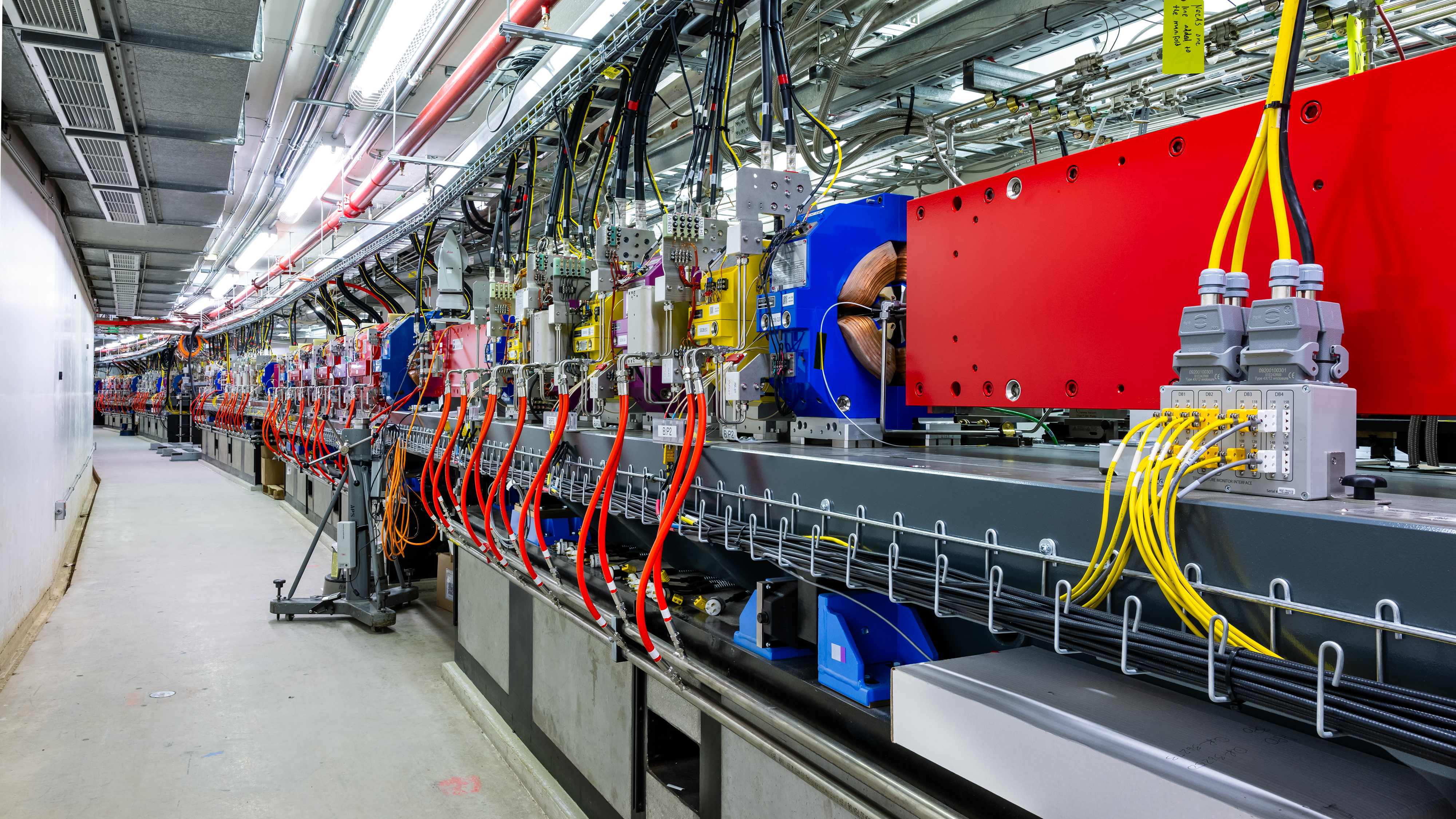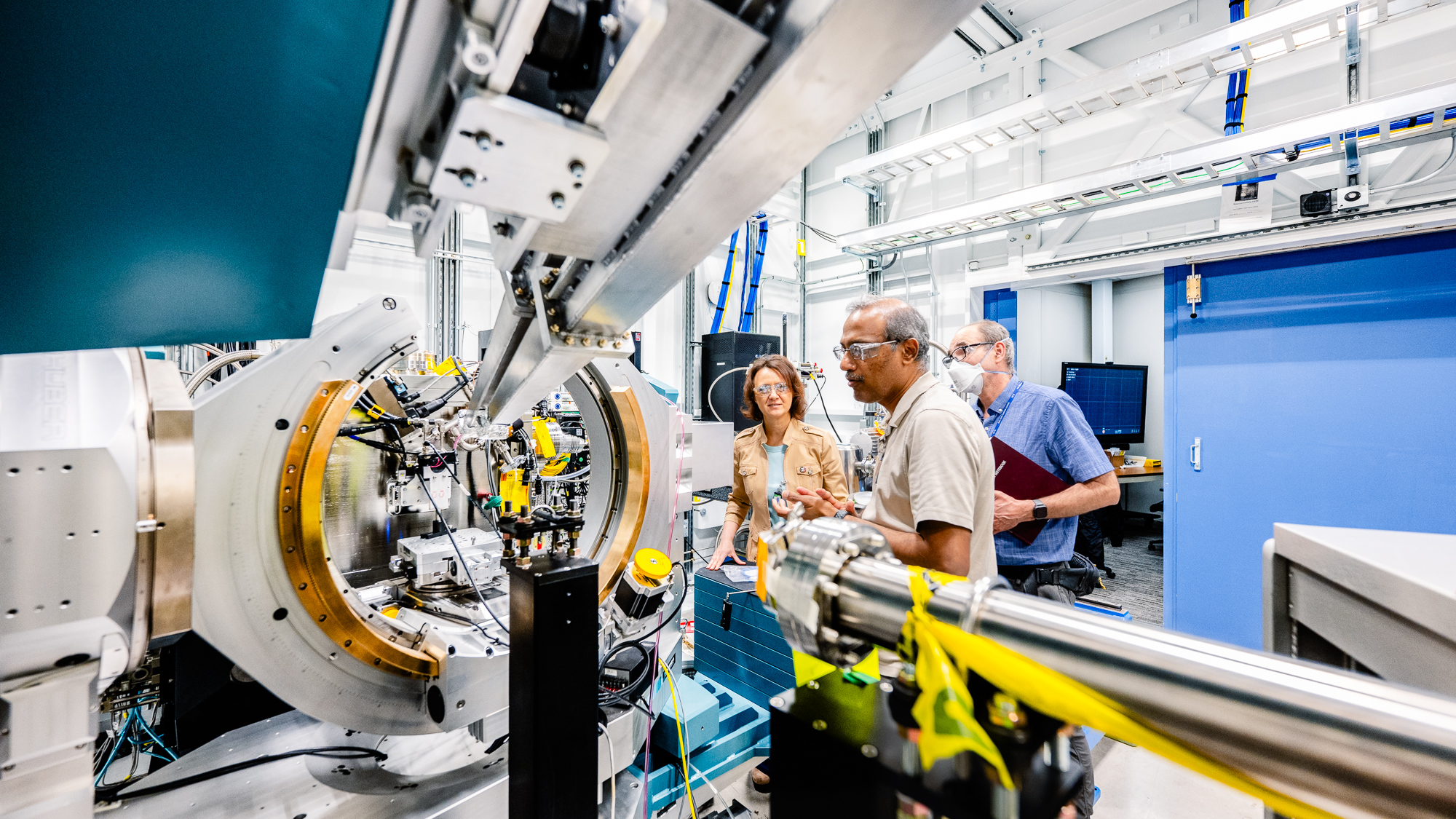by the Advanced Photon Source Upgrade Project with additional contributors
Editor’s note: In this article, APS refers to the Advanced Photon Source, not the American Physical Society
 Figure 1: The Advanced Photon Source is one of the most productive X-ray light sources in the world, and the upgraded facility has the brightest beams of any synchrotron X-ray facility. Photo by JJ Starr, Argonne.
Figure 1: The Advanced Photon Source is one of the most productive X-ray light sources in the world, and the upgraded facility has the brightest beams of any synchrotron X-ray facility. Photo by JJ Starr, Argonne.
The Advanced Photon Source (APS) is undergoing a comprehensive upgrade to transform it into a world-leading fourth-generation synchrotron light source. The original APS, operated by the U.S. Department of Energy (DOE) Office of Science at DOE’s Argonne National Laboratory, began operation in 1995. The APS offered 68 scientific beamlines and welcomed approximately 5,500 users from around the world in a typical year. During its 28 years of operation, the original APS was used by more than 33,000 unique researchers, who published nearly 41,000 papers.
The APS Upgrade project was launched to meet the research challenges of the future. One of its central objectives was to replace the original 1.1 km electron storage ring with a new multi-bend achromat lattice constructed in the same footprint. The new storage ring was designed to increase the brightness of the X-ray beams by up to 500 times and, with the incorporation of reverse-direction bending magnets, to reduce the horizontal emittance of the beam from 3 nm.rad to a final target of 42 pm.rad.
To meet those goals, a number of decisions were made during the design process. An electron beam energy of 6 GeV (instead of the 7 GeV of the original APS beam) was chosen to achieve a 36% increase in brightness. The reduced total energy loss per turn at 6 GeV allows storing a larger total beam current while lowering the power and voltage requirements for the radiofrequency (rf) systems.
A small difference in circumference between the old and new storage rings necessitated the development of a new timing system, since the original booster injector was not altered and the rf frequencies of the booster and the new storage ring are thus slightly different. With the Injection Extraction Timing System (IETS), the booster rf frequency is varied over the course of the booster cycle, so that the correct storage ring “rf bucket” is filled.
Because the strong focusing fields used to achieve the lower emittance necessitate strong nonlinear elements to correct chromatic aberrations, a new design for the injection system was required. In the 1990s the APS pioneered the use of “top-up,” replenishing the electron beam with an off-axis injection every few minutes. With the upgraded storage ring, conventional off-axis injection is not possible, so the APS is again pioneering a new system called “swap-out,” which employs fast electromagnetic deflectors to remove and replace electron bunches at intervals of 5 to 30 seconds.
Also unique among high-energy light sources is a two-meter-long superconducting cryomodule called the Bunch Lengthening System (BLS), which extends the Touschek lifetime of electron bunches. The BLS is a higher-harmonic cavity, designed to lengthen electron bunches by two to four times. Doing so also reduces the emittance-diluting effects of intra-beam scattering, resulting in lower emittance at high bunch charge.
Following a worldwide procurement effort and months of work to assemble components into the 200 modules that would be linked to form the new storage ring, operations at the APS were suspended in April 2023 to begin the removal and installation phase of the upgrade. A total of 1,321 electromagnets (of 15 varieties) were incorporated into the new storage ring, each one tested to ensure high-quality magnetic fields and each aligned with its neighbors to a tolerance of 30 microns. Nearly 2,500 power supply components, 1.2 miles of vacuum chamber, 40 miles of power and diagnostic cables and 20 miles of optical fiber were used in the assembly of the new storage ring, which took place in a warehouse working space about a mile from Argonne.
 Figure 2: The new APS electron storage ring spans more than 2/3 of a mile and includes 1,321 individually-powered magnets that are aligned to a precision of about 30 microns. Photo by Mark Lopez, Argonne.
Figure 2: The new APS electron storage ring spans more than 2/3 of a mile and includes 1,321 individually-powered magnets that are aligned to a precision of about 30 microns. Photo by Mark Lopez, Argonne.
Before the new storage ring could be installed, the original one needed to be removed. Between April 24 and June 23, 2023, 1,900 tons of equipment were carefully moved out of the APS tunnel. The magnet components of the original ring were transported to DOE’s Brookhaven and Thomas Jefferson national laboratories to use in the Electron-Ion Collider (EIC), continuing the scientific legacy of the original APS.
In summer 2023 work began to transport the new storage ring modules into the tunnel. Between July and December 2023, 200 component modules (weighing more than 30,000 pounds each), 54 front end components, 49 new and refurbished insertion devices and thousands of vacuum components were installed with extreme precision. Argonne's teams stayed below the exacting tolerance and vacuum level thresholds and the entire ring was installed, tested and checked out in nine months, a tremendous achievement. The final component of the new ring was installed on Feb. 15, 2024.
Commissioning of the new storage ring began on April 10, 2024. Owing to the precision with which the new ring was constructed, once launched on the correct trajectory the beam traveled about 400 m through the 22-mm-diameter beam pipe with no other adjustments. Within four days, electrons had circulated in the new storage ring for the first time and by April 20 the commissioning team had achieved the first stored beam in the new accelerator, at a beam current of 0.15 mA. In another first, this stored beam was achieved using a machine-learning algorithm known as Bayesian optimization. The team did encounter obstacles when the septum failed early on due to a design issue. A spare septum was retrofitted and has been operating well ever since.
Early results from commissioning pointed to a well-designed and well-assembled machine, and those results were affirmed on April 29, 2024, when the APS became the world’s first synchrotron light source to successfully use multi-bunch swap-out injection. Though conceptually simpler than top-up, swap-out requires strong, fast beam deflectors that simultaneously extract a depleted bunch and replace it with a fresh bunch. Because swap-out involves wholesale bunch replacement, it requires high charge from the injectors. APS is now the first light source to operate with more than 10 nC per bunch from the injectors.
A newly upgraded X-ray source requires upgraded beamlines to maximize its potential. The APS Upgrade Project is in the process of building and commissioning seven new beamlines and enhancing numerous others, as well as installing critical infrastructure for the completion of two more new experiment stations. The new beamlines include:
- Polarization Modulation Spectroscopy (POLAR), which combines multiple types of polarization with the ability to match the energy of X-ray beams to element-specific resonances and will be unmatched in its ability to look at the atomic electronic properties of new materials.
- X-ray Photon Correlation Spectroscopy (XPCS), specializing in the dynamics of liquids, gels, gasses and quantum materials with both wide-angle and small-angle XPCS capabilities.
- Coherent Surface Scattering Imaging (CSSI), which will enable better visualization of nano-to-millimeter-sized structures over time and in three dimensions.
- In-Situ Nanoprobe (ISN), constructed inside the newly added Long Beamline Building. ISN offers a large working distance (55 mm) while maintaining high spatial resolution for imaging — 20 nm at high X-ray energies.
- High-Energy X-ray Microscope (HEXM), also constructed in the Long Beamline Building, HEXM includes a large end station to enable imaging of larger samples and the capability to zoom down to atomic-scale resolution of those samples.
- Coherent High-Energy X-ray (CHEX), which provides eight experiment stations for long-term experiments using coherent diffraction imaging and photon correlation spectroscopy.
- PtychoProbe, the highest resolution instrument at the APS, designed to study the structures and chemical makeup of materials with ptychography and fluorescence.
 Figure 3: Members of the beamline staff work on new instrumentation for the X-ray Photon Correlation Spectroscopy (XPCS) beamline at the APS, one of seven new experiment stations to be constructed as part of the APS Upgrade Project. Photo by Jason Creps, Argonne.
Figure 3: Members of the beamline staff work on new instrumentation for the X-ray Photon Correlation Spectroscopy (XPCS) beamline at the APS, one of seven new experiment stations to be constructed as part of the APS Upgrade Project. Photo by Jason Creps, Argonne.
In June 2024, photons became available for beamlines, and on June 17, the first beamline in the APS scientific program — an enhanced station with updated resonant inelastic X-ray scattering equipment installed as part of the upgrade project — received its first light, at 50 mA of stored beam current. Since then, many other beamlines have entered scientific commissioning with beam, and users have begun returning to the APS to conduct experiments. User operations with the beam restarted on July 19 and the first general-user run on the updated machine is scheduled to begin this fall. Commissioning of the accelerator continues with the goal of achieving full power (200 mA) for user experiments.
With delivery of photons to beamlines, the electron beam emittance can be measured using undulator diagnostic systems and grating interferometry. The results of these measurements show the horizontal emittance at 45 pm.rad. in low-coupling mode and 31 pm.rad with round beam, a new world record low emittance.
With its dramatic increase in brightness and commensurate increase in coherence, the upgraded APS will enable experiments at spatial and time scales previously impossible with X-rays. The upgraded facility will pave the way for advancements in energy storage technology, microelectronics, materials science and biological and environmental research, in addition to breakthroughs in areas we have yet to imagine.